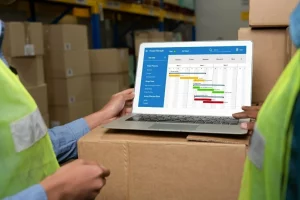Automation is fundamentally reshaping logistics efficiency in the technology era. By integrating advanced technologies such as robotics and artificial intelligence, companies are enhancing operations while reducing human error. Real-time data analytics and the Internet of Things (IoT) play pivotal roles in optimizing inventory management and tracking. As businesses adapt to these innovations, understanding their implications becomes essential. What specific advancements are leading this transformation, and how will they redefine the future of logistics?
Key Takeaways
- Automation streamlines logistics operations, significantly enhancing efficiency and reducing operational costs amid rising fuel prices and labor shortages.
- Advanced data analytics and AI improve real-time decision-making, allowing for better demand forecasting and agile supply chain management.
- Robotics and autonomous vehicles increase speed and accuracy in warehousing and transportation, minimizing human error and optimizing resource allocation.
- The Internet of Things (IoT) enables seamless communication between devices, facilitating real-time inventory management and improving delivery tracking.
- Sustainability initiatives in automated logistics attract socially conscious consumers, promoting environmentally-friendly practices while enhancing overall customer satisfaction.
The Current State of Logistics and Its Challenges
As the global economy continues to evolve, the logistics sector faces an array of challenges that hinder operational efficiency. These obstacles include rising fuel costs, fluctuating demand, and inadequate infrastructure, all of which complicate supply chain management. Additionally, labor shortages exacerbate these issues, leading to delays and increased operational costs. In this scenario, understanding how automation improves logistics efficiency becomes paramount. Automated systems can streamline processes, reduce human error, and optimize inventory management. By incorporating advanced technologies, such as robotics and artificial intelligence, logistics companies can enhance productivity and adapt to changing market dynamics. This transformational shift not only addresses existing challenges but also fosters a sense of belonging within the industry, as stakeholders unite to embrace technological advancements for collective success.
Understanding Automation in the Logistics Sector
How does automation reshape the logistics landscape? Automation in the logistics sector enhances efficiency by streamlining operations, reducing human error, and optimizing resource allocation. By integrating automated systems, organizations can achieve real-time inventory management, which fosters accurate demand forecasting and improved stock control. This transformation leads to faster processing times and increased throughput, ultimately benefiting both businesses and customers. Additionally, automation facilitates data-driven decision-making, allowing logistics managers to respond proactively to market fluctuations. As these technologies evolve, they not only enhance operational efficiency but also cultivate a culture of innovation within organizations. Consequently, understanding automation is vital for companies aiming to improve logistics efficiency, ensuring they remain competitive in an ever-changing market landscape.
Key Technologies Driving Automation in Logistics
In the rapidly evolving logistics landscape, several key technologies are driving automation and reshaping operational paradigms. Robotics and automation systems streamline warehouse operations, enhancing speed and accuracy. Advanced data analytics allow for real-time decision-making, optimizing supply chain management and inventory control. The Internet of Things (IoT) facilitates seamless communication between devices, improving tracking and visibility across logistics networks. Additionally, artificial intelligence (AI) enhances predictive analytics, enabling companies to anticipate demand fluctuations and adapt accordingly. Autonomous vehicles are also emerging, promising to revolutionize transportation efficiency. Collectively, these technologies foster a culture of innovation and adaptability, empowering organizations to navigate the complexities of modern logistics while greatly improving overall performance and responsiveness in a competitive environment.

How Automation Improves Logistics Efficiency
While the logistics industry faces increasing demands for efficiency and accuracy, automation emerges as a pivotal solution. By streamlining operations through technologies such as robotics, artificial intelligence, and data analytics, automation considerably enhances logistics efficiency. Automated systems reduce human error, optimize inventory management, and improve order fulfillment speed. For instance, warehouse automation enables real-time tracking of goods, ensuring timely deliveries and reducing congestion. Additionally, predictive analytics facilitate better decision-making, allowing organizations to anticipate demand fluctuations. The integration of automated solutions fosters a more agile supply chain, ultimately leading to cost savings and enhanced customer satisfaction. Consequently, the role of automation in improving logistics efficiency cannot be overstated, as it aligns operational capabilities with the evolving landscape of consumer expectations.
Future Trends and Innovations in Automated Logistics
As the logistics landscape continues to evolve, emerging trends and innovations in automation promise to redefine operational paradigms. The future of automated logistics is characterized by several key developments that enhance efficiency and foster community among industry participants:
- Artificial Intelligence: Elevates decision-making processes through predictive analytics.
- Robotics and Drones: Streamline delivery logistics, reducing time and labor costs.
- Blockchain Technology: Enhances transparency and trust among stakeholders.
- Internet of Things (IoT): Facilitates real-time tracking and improved inventory management.
- Sustainability Initiatives: Focus on eco-friendly practices that resonate with socially conscious consumers.
These innovations not only improve logistics efficiency but also create a sense of belonging within the industry, as companies collaboratively adapt to technological advancements.
Frequently Asked Questions
What Industries Benefit Most From Automated Logistics Solutions?
Industries such as e-commerce, manufacturing, and retail greatly benefit from automated logistics solutions. These sectors experience enhanced efficiency, reduced operational costs, and improved accuracy, ultimately fostering a competitive edge in an increasingly dynamic marketplace.
How Does Automation Affect Job Opportunities in Logistics?
Automation considerably impacts job opportunities in logistics by reducing manual labor roles while creating demand for skilled positions in technology management and data analysis, ultimately reshaping the workforce landscape towards more specialized, high-value jobs.
What Are the Costs Associated With Implementing Logistics Automation?
Implementing logistics automation incurs costs such as initial investment in technology, ongoing maintenance, employee training, and potential system integration challenges. However, these expenses can lead to significant long-term savings and improved operational efficiency.
Can Small Businesses Adopt Automation in Logistics Effectively?
Small businesses can effectively adopt automation in logistics by leveraging scalable solutions that enhance operational efficiency. This approach minimizes costs, optimizes workflows, and allows them to compete with larger entities in an increasingly automated marketplace.
How Do Companies Measure the Success of Logistics Automation?
Companies measure the success of logistics automation through key performance indicators, including cost savings, delivery times, inventory accuracy, and customer satisfaction. These metrics provide valuable insights into efficiency gains and operational improvements achieved through automation.
Conclusion
In summary, automation stands as a vital force reshaping logistics efficiency in the technology era. By integrating advanced technologies such as robotics, artificial intelligence, and IoT, companies are not only overcoming traditional challenges but also optimizing operations for enhanced speed and accuracy. This transformation enables agile supply chains and proactive demand management, ultimately leading to superior customer satisfaction. As logistics continues to evolve, embracing these innovations will be essential for companies aiming to thrive in an increasingly competitive landscape.
You May Also Like To Read:





